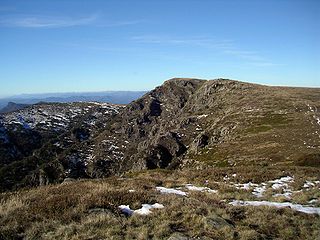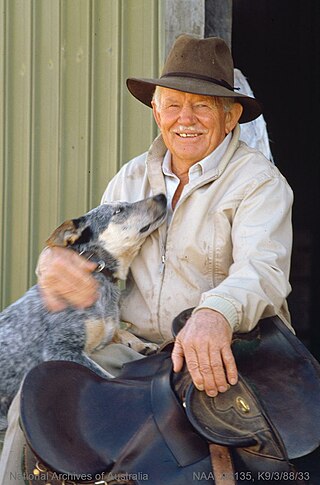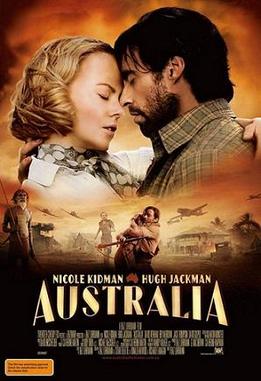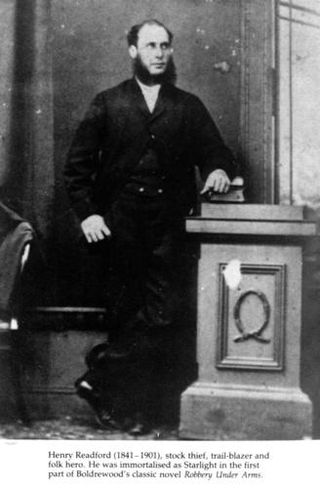Related Research Articles

The Alpine National Park is a national park located in the Central Highlands and Alpine regions of Victoria, Australia. The 646,000-hectare (1,600,000-acre) national park is located northeast of Melbourne. It is the largest National Park in Victoria, and covers much of the higher areas of the Great Dividing Range in Victoria, including Victoria's highest point, Mount Bogong at 1,986 metres (6,516 ft) and the associated subalpine woodland and grassland of the Bogong High Plains. The park's north-eastern boundary is along the border with New South Wales, where it abuts the Kosciuszko National Park. On 7 November 2008 the Alpine National Park was added to the Australian National Heritage List as one of eleven areas constituting the Australian Alps National Parks and Reserves.

Jedda, released in the UK as Jedda the Uncivilised, is a 1955 Australian film written, produced and directed by Charles Chauvel. His last film, it is notable for being the first to star two Aboriginal actors, Robert Tudawali and Ngarla Kunoth in the leading roles. It was also the first Australian feature film to be shot in colour.

In Australia, a station is a large landholding used for producing livestock, predominantly cattle or sheep, that needs an extensive range of grazing land. The owner of a station is called a pastoralist or a grazier, corresponding to the North American term "rancher".
Sara Jane Henderson was an Australian pastoralist and author who became an Australia household name after the publication of her autobiography From Strength to Strength in 1993 about rebuilding Bullo River cattle station in the Northern Territory of Australia.

Reginald Murray Williams was an Australian bushman and entrepreneur who rose from a swagman to a millionaire. He was born at Belalie North near Jamestown in the Mid North of South Australia, 200 kilometres (120 mi) north of Adelaide CBD, into a pioneering settler family working and training horses. Williams had many adventures in Australia's rugged outback as a bushman, and became known for creating an Australian style of bushwear clothing and footwear recognised worldwide and the company that bore his name.

In Australia and New Zealand, a cattle station is a large farm, the main activity of which is the rearing of cattle. The owner of a cattle station is called a grazier. The largest cattle station in the world is Anna Creek Station in South Australia, which covers an area of 23,677 square kilometres.

Australia is a 2008 epic adventure drama film directed by Baz Luhrmann and starring Nicole Kidman and Hugh Jackman. The screenplay was written by Luhrmann and screenwriter Stuart Beattie, with Ronald Harwood and Richard Flanagan. The film is a character story, set between 1939 and 1942 against a dramatised backdrop of events across northern Australia at the time, such as the bombing of Darwin during World War II.

Henry Arthur Readford, was an Australian stockman, drover and cattle thief.
We of the Never Never is an autobiographical novel by Jeannie Gunn first published in 1908. Although published as a novel, it is an account of the author's experiences in 1902 at Elsey Station near Mataranka, Northern Territory in which she changed the names of people to obscure their identities. She published the book under the name Mrs Aeneas Gunn, using her husband's first and last name. Over the years, newspapers and magazine articles chronicled the fortunes of the Elsey characters. Jeannie outlived all but Bett-Bett.
The Last Frontier is a 1986 American-Australian television miniseries starring Linda Evans, Jack Thompson and Jason Robards.
Balfour Downs Station is a pastoral lease and cattle station located approximately 132 kilometres (82 mi) northeast of Newman, 88 kilometres (55 mi) east of Roy Hill and 108 kilometres (67 mi) southeast of Nullagine in the Pilbara region of Western Australia. At 6,395 square kilometres (2,469 sq mi), it is among the largest cattle stations in Australia.

Alexandria Station is a pastoral lease that operates as a cattle station. It is the Northern Territory's largest pastoral property and Australia's third largest pastoral property, after Anna Creek station and Clifton Hills Station.
Litchfield Station is a pastoral lease that operates as a cattle station. It is located about 44 kilometres (27 mi) north west of Daly River and 69 kilometres (43 mi) west of Adelaide River in the Northern Territory of Australia. Composed primarily of open grazing land, the property occupies an area of 1,336 square kilometres (516 sq mi). The two adjoining sister properties are Elizabeth Downs and Tipperary Stations; all three currently operate as a single entity, often referred to as the Tipperary Group.
Durham Downs Station, most commonly known as Durham Downs, is a pastoral lease that operates as a cattle station in Durham, Shire of Bulloo in South West Queensland, Australia. The property is situated in a remote and arid location along Cooper Creek, where it often experiences drought and floods. It was originally established in the 1870s and belongs to S. Kidman & Co, which since 2016 has been owned by Gina Rinehart.

Dunbar Station is a pastoral lease that currently operates as a cattle station in Queensland, Australia. The homestead is located on the Burke Developmental Road, Maramie in the Shire of Carpentaria.

Bullo River Station also once known as Bullo River Valley Station, is a pastoral lease that operates as a cattle station in the Northern Territory of Australia.
Ban Ban Springs Station is a pastoral lease that operates as a cattle station in the Northern Territory of Australia.
Bonney Downs Station is a pastoral lease that was once a sheep station but now operates as a cattle station in Western Australia.
Marie Therese "Terry" Underwood is a best-selling Australian author who lived on a remote cattle station in the Northern Territory of Australia.
References
- ↑ Verghis, Sharon (5 April 2003). "Land of Beef and Bad Blood". The Sydney Morning Herald. Retrieved 18 January 2018.
- 1 2 3 Ranacher, Marlee (2003). Bullo: The Next Generation. Sydney, New York, Toronto, London, Auckland, Johannesburg: Random House Australia Pty Ltd. pp. Front and back cover. ISBN 1740511557.
- ↑ Breen, Fiona (18 March 2017). "From the outback to the ends of the earth: the farmer working at Antarctica's Wilkins Runway". ABC News. Retrieved 8 February 2018.
- ↑ Ranacher, Marlee (18 January 2018). "Marlee Ranacher". LinkedIn.
- ↑ "World Famous Bullo River Station Sells". Beefcentral. 18 January 2018.
- ↑ "Marlee Ranacher". Platinum Speakers. 18 January 2018.
- ↑ Puddy, Rebecca (29 June 2011). "Export ban last straw for iconic cattle station". The Australian. Retrieved 8 February 2018.
- ↑ Sheehan, Paul (15 August 2011). "Cattlemen driven to desperation by Canberra". Sydney Morning Herald. Retrieved 8 February 2018.
- ↑ Walker, Helen (18 January 2018). "Bullo River Station Sells". Queensland Country Life.
- ↑ "Marlee Ranacher". ICMI speakers&entertainers. 2016. Retrieved 24 January 2018.